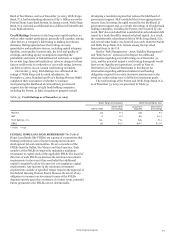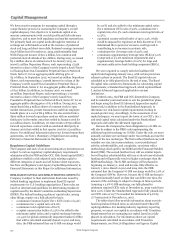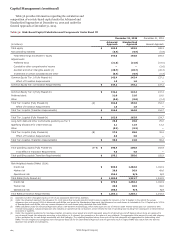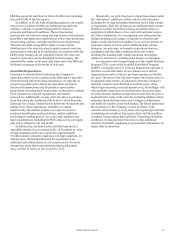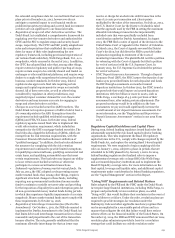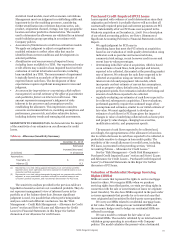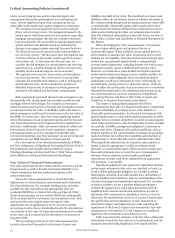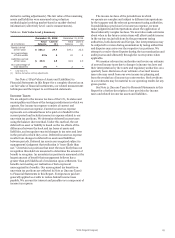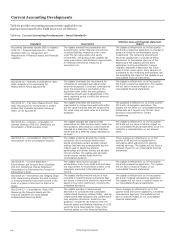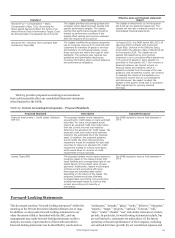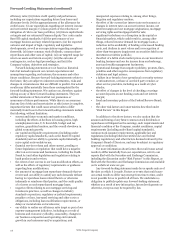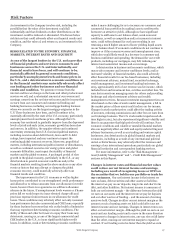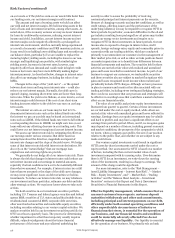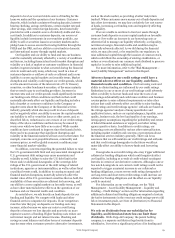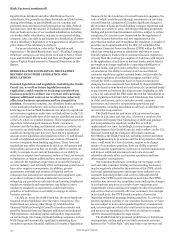Wells Fargo 2015 Annual Report Download - page 112
Download and view the complete annual report
Please find page 112 of the 2015 Wells Fargo annual report below. You can navigate through the pages in the report by either clicking on the pages listed below, or by using the keyword search tool below to find specific information within the annual report.
Regulatory Reform (continued)
bankruptcy; however, they identified specific shortcomings in
the 2014 resolution plan that would need to be addressed in the
2015 resolution plan. We submitted our 2015 resolution plan on
June 29, 2015, but have not yet received regulatory feedback on
the plan. If the FRB and FDIC determine that our resolution
plan is deficient, the Dodd-Frank Act authorizes the FRB and
FDIC to impose more stringent capital, leverage or liquidity
requirements on us or restrict our growth or activities until we
submit a plan remedying the deficiencies. If the FRB and FDIC
ultimately determine that we have been unable to remedy the
deficiencies, they could order us to divest assets or operations in
order to facilitate our orderly resolution in the event of our
material distress or failure. Our national bank subsidiary,
Wells Fargo Bank, N.A., is also required to prepare a resolution
plan for the FDIC under separate regulatory authority and
submitted its third annual resolution plan on June 29, 2015.
We must also prepare and submit to the FRB on an annual
basis a recovery plan that identifies a range of options that we
may consider during times of idiosyncratic or systemic economic
stress to remedy any financial weaknesses and restore market
confidence without extraordinary government support. Recovery
options include the possible sale, transfer or disposal of assets,
securities, loan portfolios or businesses. In December 2015, the
OCC published a notice of proposed rulemaking on guidelines to
establish standards for recovery planning by large insured
national banks, such as Wells Fargo Bank, N.A. The guidelines
Critical Accounting Policies
would require a bank to develop and maintain a recovery plan
that sets forth the bank’s plan to remain a going concern when
the bank is experiencing considerable financial or operational
stress, but has not yet deteriorated to the point where liquidation
or resolution is imminent. If either the FRB or the OCC
determine that our recovery plan is deficient, they may impose
restrictions on our business or ultimately require us to divest
assets.
The Dodd-Frank Act also establishes an orderly liquidation
process which allows for the appointment of the FDIC as a
receiver of a systemically important financial institution that is
in default or in danger of default. The FDIC has issued rules to
implement its orderly liquidation authority and released a notice
and request for comment regarding a proposed resolution
strategy, known as “single point of entry,” designed to resolve a
large financial institution in a manner that holds management
responsible for its failure, maintains market stability, and
imposes losses on shareholders and creditors in accordance with
statutory priorities, without imposing a cost on U.S. taxpayers.
Implementation of the strategy would require that institutions
maintain a sufficient amount of available equity and unsecured
debt to absorb losses and recapitalize operating subsidiaries. The
FDIC has not issued any final statements on the single point of
entry resolution strategy.
Our significant accounting policies (see Note 1 (Summary of
Significant Accounting Policies) to Financial Statements in this
Report) are fundamental to understanding our results of
operations and financial condition because they require that we
use estimates and assumptions that may affect the value of our
assets or liabilities and financial results. Five of these policies are
critical because they require management to make difficult,
subjective and complex judgments about matters that are
inherently uncertain and because it is likely that materially
different amounts would be reported under different conditions
or using different assumptions. These policies govern:
• the allowance for credit losses;
• PCI loans;
• the valuation of residential MSRs;
• the fair value of financial instruments; and
• income taxes.
Management and the Board's Audit and Examination
committee have reviewed and approved these critical accounting
policies.
Allowance for Credit Losses
We maintain an allowance for credit losses, which consists of the
allowance for loan losses and the allowance for unfunded credit
commitments, which is management’s estimate of credit losses
inherent in the loan portfolio, including unfunded credit
commitments, at the balance sheet date, excluding loans carried
at fair value. For a description of our related accounting policies,
see Note 1 (Summary of Significant Accounting Policies) to
Financial Statements in this Report.
Changes in the allowance for credit losses and, therefore, in
the related provision for credit losses can materially affect net
income. In applying the review and judgment required to
determine the allowance for credit losses, management
considers changes in economic conditions, customer behavior,
and collateral value, among other influences. From time to time,
economic factors or business decisions, such as the addition or
liquidation of a loan product or business unit, may affect the
loan portfolio, causing management to provide or release
amounts from the allowance for credit losses. While our
methodology attributes portions of the allowance to specific
portfolio segments (commercial and consumer), the entire
allowance for credit losses is available to absorb credit losses
inherent in the total loan portfolio and unfunded credit
commitments.
Judgment is specifically applied in:
• Credit risk ratings applied to individual commercial loans
and unfunded credit commitments. We estimate the
probability of default in accordance with the borrower’s
financial strength using a borrower quality rating and the
severity of loss in the event of default using a collateral
quality rating. Collectively, these ratings are referred to as
credit risk ratings and are assigned to our commercial loans.
Probability of default and severity at the time of default are
statistically derived through historical observations of
defaults and losses after default within each credit risk
rating. Commercial loan risk ratings are evaluated based on
each situation by experienced senior credit officers and are
subject to periodic review by an internal team of credit
specialists.
• Economic assumptions applied to pools of consumer loans
(statistically modeled). Losses are estimated using
economic variables to represent our best estimate of
inherent loss. Our forecasted losses are modeled using a
range of economic scenarios.
• Selection of a credit loss estimation model that fits the
credit risk characteristics of its portfolio. We use both
internally developed and vendor supplied models in this
process. We often use expected loss, roll rate, net flow,
vintage maturation, behavior score, and time series or
Wells Fargo & Company
110



